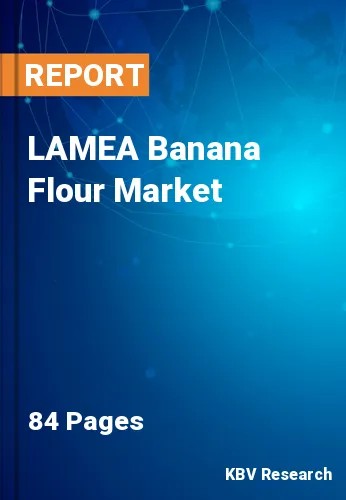The Latin America, Middle East and Africa Banana Flour Market would witness market growth of 8.9% CAGR during the forecast period (2022-2028).
In tropical and subtropical regions, the banana is one of the most widely consumed and utilized fruits. Green bananas are utilized to produce banana flour. It is high in dietary fibers, carbs, protein, cellulose, necessary amino acids, starch, resistant starch, and potassium, among other things. It's a gluten-free product with a low-calorie count. As a result, there has been an increase in demand for banana flour. These factors are significantly propelling the growth of the banana flour market.
Banana flour is a calorie and carbohydrate-rich powder made from the processing of bananas. Because it helps to soothe ulcers, improves energy, aids in improved digestion, and maintains a healthy neurological system, it is extensively used as a component in infant foods, milkshakes, and bakery items. It also has natural laxative effects, which is why pharmaceutical companies employ it to make anti-diarrhea medicines.
Regional countries comprise a robust retail sector, due to which, market players across the region are witnessing several major growth prospects. In 2013, the retail sector contributed about 12% to the overall GDP, representing a 9% increase over the previous year. A total of 1,732,000 individuals were working in the retail and wholesale industries, accounting for nearly 21% of the national workforce. As a result, the retail business is a significant part of the South African economy. South Africa's overall retail sales in 2013 were R406.2 billion (USD $38 billion). Retail sales have increased steadily throughout the last five years and are predicted to increase by nearly 5% per year over the next five years. Sales were expected to exceed R424.8 billion (USD $40 billion) in 2014.
The retail market in South Africa could be sophisticated and complex. A smart entry strategy should consider that the top 10% of the population earns 45% income and that the majority of significant retail locations are centered in the five metropolitan districts. The rapidly expanding retail industry of the region would streamline banana flour manufacturers to easily commercialize their products across the market. Therefore, the growth of the regional market is being propelled due to this factor.
The Brazil market dominated the LAMEA Banana Flour Market by Country in 2021, and would continue to be a dominant market till 2028; thereby, achieving a market value of $25.3 million by 2028. The Argentina market is experiencing a CAGR of 9.5% during (2022 - 2028). Additionally, The UAE market would exhibit a CAGR of 8.6% during (2022 - 2028).
Based on Nature, the market is segmented into Conventional and Organic. Based on Processing, the market is segmented into Spray/Drum Dried, Sun Dried, Freeze Dried, and Others. Based on Form, the market is segmented into Unripen and Ripen. Based on Distribution Channel, the market is segmented into Direct Sales and Indirect Sales. Based on End-use, the market is segmented into Food Industry, Beverages, Retail/Household, and Others. Based on countries, the market is segmented into Brazil, Argentina, UAE, Saudi Arabia, South Africa, Nigeria, and Rest of LAMEA.
Free Valuable Insights: The Global Banana Flour Market is Predict to reach $1.1 Billion by 2028, at a CAGR of 6.5%
The market research report covers the analysis of key stake holders of the market. Key companies profiled in the report include Symrise AG (Diana Foods), Woodland Foods Limited, Saipro Biotech Private Limited, LiveKuna, Pereg Natural Foods Inc., Seawind International, LLC, NuNaturals Ltd., Miski Organics (Miski Group), and Synergy Food Industries.
By Nature
By Processing
By Form
By Distribution Channel
By End-use
By Country
Our team of dedicated experts can provide you with attractive expansion opportunities for your business.

